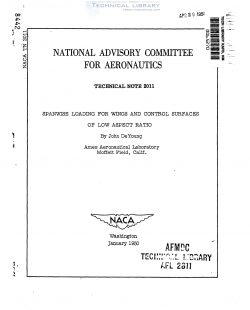naca-tn-2011
- Version
- 91 Downloads
- 1.15 MB File Size
- 1 File Count
- December 13, 2016 Create Date
- December 13, 2016 Last Updated
National Advisory Committee for Aeronautics, Technical Notes - Spanwise Loading for Wings and Control Surfaces of Low Aspect Ratio

The boundary conditions for lowuaspect—ratio wings are approxi—
mately satisfied by a tweedimensional vortex sheet that extends to
infinity fore and aft. Since the downwash is constant fore and aft,
the boundary condition that no flow passes through the wing or flat
plate is satisfied simply by the familiar downwash integral used in
line-theory loading methods. A theory is developed herein, based on
the foregoing principle which (for small aerodynamic angles and for
plan forms that have all points of the trailing edge at or behind the
upstream line of maximum Span) Will predict the spanwise loading due to
'arbitrary Spanwise angle-of—attack distribution, including (1) uniform
angle of attack, (2) that induced by rolling, (3) spanwise variation of
twist or camber, and (h) that due to deflection of arbitrary control
surfaces of low aspect ratio. The spanwise loadings are independent of
the plan forms considered.
It is found for plan forms having unswept trailing edges that the
spanwise loading distribution depends only on the slope of the region
at the wing trailing edge. Thus, in the limit case of zero aspect ratio
of wings and control surfaces, the spanwise loading is independent of the
position of the hinge line along the wing chord. In addition, the total
loading due to any chordwise camber distribution depends only on the
slope at the wing trailing edge, provided the curvature at the trailing
edge is small as compared with the slope.
From considerations of the linearizedrcompressible—flow equation,
the aerodynamic values given by zero—aspect—ratio theory are also those
of moderate-aspect—ratio wings at the speed of sound. The results are
applicable for low values of the product of the Prandtl—Glauert com-
pressibility parameter and aspect ratio.
The aerodynamic characteristics of pointedrwing plan forms with p
aspect ratio approaching zero have been considered by R. T. Jones
(reference 1) and extended by H. S. Ribner (reference 2) to include all
the stability derivatives for the pointed triangular wing. The triangu-
lar wing of references 1 and 2 is treated on the assumption that the
flow potential in planes at right angles to the long axis of the airfoil
is similar to the corresponding two—dimensional potential. This theory
gives'the surface loading for the.flat plate and can be extended to the
computation of all the important aerodynamic characteristics.
| File | Action |
|---|---|
| naca-tn-2011 Spanwise Loading for Wings and Control Surfaces of Low Aspect Ratio.pdf | Download |

Comment On This Post